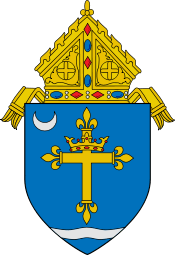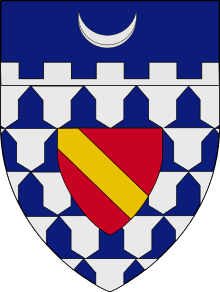John Carberry
| His Eminence John Joseph Carberry | |
|---|---|
| Cardinal, Archbishop emeritus of St. Louis | |
| See | St. Louis |
| Appointed | February 17, 1968 |
| Installed | March 25, 1968 |
| Term ended | July 31, 1979 |
| Predecessor | Joseph Ritter |
| Successor | John L. May |
| Other posts | Cardinal-Priest of San Giovanni Battista de’ Rossi |
| Orders | |
| Ordination |
July 28, 1929 by Francesco Marchetti Selvaggiani |
| Consecration |
July 25, 1956 by Raymond Augustine Kearney |
| Created Cardinal |
April 28, 1969 by Paul VI |
| Rank | Cardinal-Priest |
| Personal details | |
| Born |
July 31, 1904 Brooklyn, New York |
| Died |
June 17, 1998 (aged 93) Kirkwood, Missouri |
| Previous post |
|
| Motto |
MARIA REGINA MATER (Mary Queen Mother) |
| Coat of arms |
 |
| Styles of John Joseph Carberry | |
|---|---|
 | |
| Reference style | His Eminence |
| Spoken style | Your Eminence |
| Informal style | Cardinal |
| See | St. Louis |
John Joseph Cardinal Carberry (July 31, 1904 – June 17, 1998) was an American prelate of the Roman Catholic Church. He served as Archbishop of St. Louis from 1968 to 1979, and was created a cardinal in 1969. He previously served as Bishop of Lafayette in Indiana (1957–65) and Bishop of Columbus (1965–68).
Biography
Early life and education
John Carberry was born in Brooklyn, New York, the youngest of ten children of James Joseph and Mary Elizabeth (née O'Keefe) Carberry.[1] His father worked as a clerk at Kings County Court.[2] He received his early education at the parochial school of St. Boniface Church in his native city.[3] In 1919, at age 15, he enrolled at Cathedral College.[4] He there excelled in both baseball and the violin.[3]
From 1924 to 1930, Carberry studied for the priesthood in Rome, where he resided at the Pontifical North American College.[2] He earned a doctorate in philosophy (1929) and a doctorate in theology (1930) from the Pontifical Urbaniana University.[5]
Ordination and ministry
On June 28, 1929, Carberry was ordained a priest by Cardinal Francesco Marchetti Selvaggiani in Rome.[6] Following his return to New York, he was assigned as a curate at St. Peter's Church in Glen Cove, where he remained for one year.[5] He continued his studies at the Catholic University of America in Washington, D.C., where he received a doctorate in canon law in 1934.[1] He then served as a curate at St. Patrick's Church in Huntington for one year.[5]
From 1935 to 1940, Carberry was on loan to the Diocese of Trenton in New Jersey, serving as secretary to Bishop Moses E. Kiley and assistant chancellor of the diocese.[5] He also taught at Cathedral High School in Trenton from 1939 to 1940.[2] Returning to New York, he taught at St. Dominic High School in Oyster Bay before serving as professor of canon law at Immaculate Conception Seminary in Huntington from 1941 to 1945.[2]
Carberry was an officialis of the Diocese of Brooklyn from 1945 to 1956, serving as chief judge of the diocesan court.[7] He also served as diocesan director for radio and television, becoming known as the "radio priest."[3] He was named a papal chamberlain on February 3, 1948, and raised to the rank of domestic prelate on May 7, 1954.[1] From 1955 to 1956, he was president of the Canon Law Society of America.[5]
Bishop of Lafayette in Indiana
On May 3, 1956, Carberry was appointed coadjutor bishop of the Diocese of Lafayette, Indiana, and titular bishop of Elis by Pope Pius XII.[6] He received his episcopal consecration on the following July 25 from Bishop Raymond Augustine Kearney, with Bishops George W. Ahr and John Benjamin Grellinger serving as co-consecrators, at the Our Lady of Perpetual Help Church.[6] He selected as his episcopal motto: Maria, Regina Mater (Latin: "Mary, Queen and Mother").[2] His installation took place at the Cathedral of St. Mary on August 22 of that year.[6]
Upon the death of Bishop John George Bennett, Carberry succeeded him as the second Bishop of Lafayette on November 20, 1957.[6] He convened the first diocesan synod and established the Diocesan Council of Men and the Society for Priestly Vocations during his tenure.[2] He attended all four sessions of the Second Vatican Council between 1962 and 1965.[1] During its third session, he addressed the Council on Dignitatis humanae, the declaration on religious liberty.[2]
Bishop of Columbus, Ohio
Carberry was appointed the seventh Bishop of Columbus, Ohio, by Pope Paul VI on January 16, 1965.[6] He was installed at St. Joseph's Cathedral on the following March 25.[6] During his tenure in Columbus, he implemented the reforms of the Second Vatican Council and supported the civil rights and ecumenical movements.[3] He established the Clergy Advisory Council, and oversaw the renovation of St. Joseph's Cathedral after issuing regulations for liturgical changes.[3] He also bought a new building to centralize the offices of the diocesan chancery.[3] In 1966, he was named by Cardinal Francis Spellman as vicar delegate of the Military Ordinariate for Ohio, West Virginia, Kentucky, Tennessee, Mississippi, and Alabama.[2]
As a member of the National Conference of Catholic Bishops, Carberry served as chairman of the Committee on Ecumenical and Interreligious Affairs from 1965 to 1969.[8] He helped found the Inter-Church Board for Metropolitan Affairs, the first organization in the United States uniting Protestants and Catholics for ecumenism and social action.[3] In January 1968, he became the first Catholic bishop to receive the Ohio Council of Churches' annual "Pastor of Pastors" award.[8]
Archbishop of St. Louis
On February 14, 1968, Carberry was appointed the fifth Archbishop of St. Louis, Missouri.[6] His installation took place at the Cathedral of St. Louis on March 25 of that year.[6] Carberry was considered more theologically conservative than his predecessor, Cardinal Joseph Ritter.[4][8] One publication even described him as being "threatened by a world he does not understand."[9] He strongly defended Humanae vitae, and created the Archdiocesan Pro-Life Commission.[10] Paul VI created him Cardinal Priest of S. Giovanni Battista de Rossi a via Latina in the consistory of April 28, 1969.[1] In 1972, Carberry established the Urban Services Apostolate for inner-city parishes in the archdiocese.[2] He was elected vice-president of the National Conference of Catholic Bishops in 1974, and was a delegate to the World Synod of Bishops in 1972, 1974 and 1976.[11] Carberry initially opposed the reception of communion by hand, believing it was irreverent and risked the possibility of stealing Hosts to use at Black Masses.[12] However, he later permitted this practice in St. Louis in 1977.[2] That same year, he ordained the first permanent deacons in the archdiocese.[11]
He was one of the cardinal electors who participated in the conclaves of August and October 1978, which selected Popes John Paul I and John Paul II, respectively. Carberry helped lead an internal campaign against the liberal Archbishop Jean Jadot, the Apostolic Delegate to the United States, whom he perceived as "destroying the Catholic Church in the United States."[13] He was a vocal critic of the television sitcom Maude, which he said "injected CBS-TV as advocate of a moral and political position that many not only oppose but find positively offensive as immoral...The decision to secure an abortion or the decision to have a vasectomy, even for those who choose them, is hardly a joke."[14]
Later life and death
Upon reaching the mandatory retirement age of 75, Carberry resigned as Archbishop of St. Louis on July 31, 1979.[6] He was succeeded by Bishop John L. May, then serving as Bishop of Mobile.[15] After suffering a stroke in 1988, he moved into St. Agnes Home in Kirkwood.[2]
Carberry later died at St. Agnes Home, at age 93.[4] He is buried in the crypt of the Cathedral of St. Louis.[1]
References
- 1 2 3 4 5 6 Miranda, Salvador. "CARBERRY, John Joseph (1904-1998)". The Cardinals of the Holy Roman Church.
- 1 2 3 4 5 6 7 8 9 10 11 Jackson, Kenneth T.; Markoe, Karen (2002). The Scribner Encyclopedia of American Lives. V. Arnie Markoe. New York: Charles Scribner's Sons.
- 1 2 3 4 5 6 7 "The Bishops of Columbus". Roman Catholic Diocese of Columbus.
- 1 2 3 Saxon, Wolfgang (1998-06-19). "John J. Cardinal Carberry, 93; Led Archdiocese of St. Louis". The New York Times.
- 1 2 3 4 5 Curtis, Georgina Pell (1961). The American Catholic Who's Who. XIV. Grosse Pointe, Michigan: Walter Romig.
- 1 2 3 4 5 6 7 8 9 10 "John Joseph Cardinal Carberry". Catholic-Hierarchy.org.
- ↑ "Brooklyn Priest Named As a Bishop in Indiana". The New York Times. 1956-05-10.
- 1 2 3 "New Bishop for St. Louis". TIME Magazine. 1968-03-01.
- ↑ "Papal Oddsmaking". TIME Magazine. 1978-07-17.
- ↑ "Princely Promotions". TIME Magazine. 1969-04-04.
- 1 2 "1946-1994: The St. Louis Church in the Modern World". Roman Catholic Archdiocese of St. Louis.
- ↑ "Replying to A Call to Action". TIME Magazine. 1977-05-16.
- ↑ Dick, John A. (2009-01-21). "Cleric who shaped U.S. 'pastoral church' dead at 99". National Catholic Reporter.
- ↑ "Tidings". TIME Magazine. 1973-01-22.
- ↑ "Archbishop John Lawrence May". Catholic-Hierarchy.org.
External links
- Roman Catholic Diocese of Lafayette, Indiana Official website
| Catholic Church titles | ||
|---|---|---|
| Preceded by Joseph Ritter |
Archbishop of St. Louis 1968–1979 |
Succeeded by John L. May |
| Preceded by Clarence George Issenmann |
Bishop of Columbus 1965–1968 |
Succeeded by Clarence Edward Elwell |
| Preceded by John George Bennett |
Bishop of Lafayette in Indiana 1957–1965 |
Succeeded by Raymond Joseph Gallagher |


